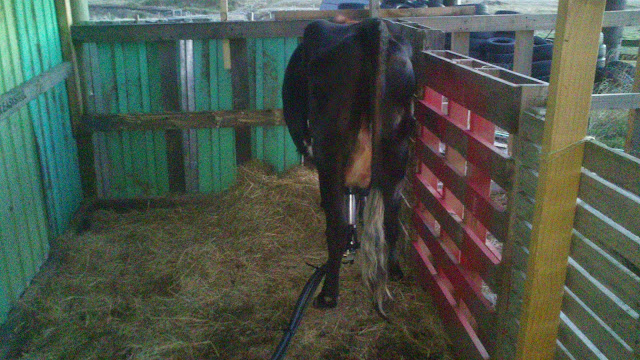I wrote some time ago sharing
two patterns for socks. While both worked, I found the triangular type heel on the second pattern seemed to wear very quickly and all the socks I'd made got holes in them around the heel. Perhaps I didn't make the soles long enough.
I found another pattern that has a squarer heel that is simple and seems to work and last better.
The yarn I use is my double knit sized homespun. I've made socks for a size 12 foot and socks for a size 9 using the same amount of stitches around, just varying the length of foot and they've fit everyone they've been made for. I know many patterns increase the number of stitches in a round for the size of foot, but I've found that to be completely unnecessary.
The wool I've been spinning is Texel fleece. I was frequently told that Texels are a meat breed and their wool isn't used for much. I live in sheep farming country and most of my neighbours have been farming sheep for their entire lives. I spent a bit of time on Google specifically looking for Texel wool uses and found that it's a sturdy fibre that keeps it's springiness, it's often used in hosiery and is a favourite for needle felting. Socks it is then.
The first three pairs of socks I made out of my homespun Texel wool were for people that I knew to be very hard on their socks. I've told them they're my guinea pigs and I want them to be honest about how their socks wear.
My father, in particular, is hard on socks. His odd shaped feet just aren't catered to by sock manufacturers. His big toe is his longest toe by quite a lot, and the difference between the end of his big toe and the start of the slant from his little pinky toe is about 8cm (3 inches). So I made his socks shaped to his feet. He has quite a distinct left foot and right foot. They fitted perfectly and I think he was surprised by this, even if they look a bit odd when not on his feet.
I've learned that a shorter leg length (above the heel) is not practical in socks. I think when I was making those ones, I was bored with just going around and around and decided that I liked short ankle socks. These socks now fall of when I take my foot out of a gumboot, actually they fall off constantly. I picked up the stitches at the top of the cuff and added an extra stretch of ribbing. They stay on much better now.
 |
| Showing the extra band I added at the top |
My current sock pattern is:
Socks
Note: Check out the page for
knitting abbreviations.
With 3.25mm sock needles, loosely cast on 48 sts and distribute evenly between three needles in a round, taking care not to twist the starting round.
Work in K2 P2 rib to desired length for cuff, then K all stitches to desired length to heel. Adjust the stitches so that 24 sts are on the needle for the heel and 12 sts each on the other two.
Heel
Next Row: K all 24 sts on the needle, turn.
Next Row: P back across those 24 sts.
Continue working on only these sts for 12 more rows.
Turn Heel
Row 1 (RS): K13, sl 1, k1, psso, k1 turn.
Row 2 (WS): Sl 1, p3, p2tog, p1, turn.
Row 3: Sl 1, k4, sl 1, k1, psso, k1, turn.
Row 4: Sl 1, p5, p2tog, p1, turn.
Row 5: Sl 1, k6, sl 1, k1, psso, k1, turn.
Row 6: Sl 1, p7, p2tog, p1, turn.
Continue in this manner until 14 sts remain ending with a WS row.
Next Row: K to end, pick up and k 11 sts down the side of heel, knit across other two needles putting sts from both onto one needle, pick up and k 11 up the other side of heel and k 7 from last needle onto that needle. The needles that have the picked up stitches should now have half each of the heel sts with the other needle holding 24 of the sts that were unworked during the heel shaping.
Next Round: K all sts for 2 rounds, starting and finishing in the centre of the heel.
Gusset
Next Round: K to last 3 sts of first needle, k2tog, k1; k across all 24 sts of next needle, on third needle, k1, sl 1, k1, psso, k to end.
Next Round: K all sts.
Next Round: K to last 3 sts of first needle, k2tog, k1; k across all 24 sts of next needle, on third needle, k1, sl 1, k1, psso, k to end.
Next Round: K all sts.
Continue to decrease in this manner until first and third needles each contain 12 sts - 48 sts in total.
Foot
Next Round: K all sts.
Repeat this round until foot measures approx 3.5cm (1 1/4 inch) less than required length.
Toe
Next Round: K to last 3 sts of first needle, k2tog, k1; second needle, k1, sl 1, k1, psso, k to last 3 sts of second needle, k2tog, k1; third needle, k1, sl 1, k1, psso, k to end.
Next Round: K 1 round straight.
Repeat these two rounds 3 times more - until there are 32 sts total.
Continue to decrease in every round for the next five rounds - until 12 sts remain in total.
Either graft front and back together, or cast off loosely and join seam.
 |
| A sock currently part way up the foot. Showing the heel working. |







